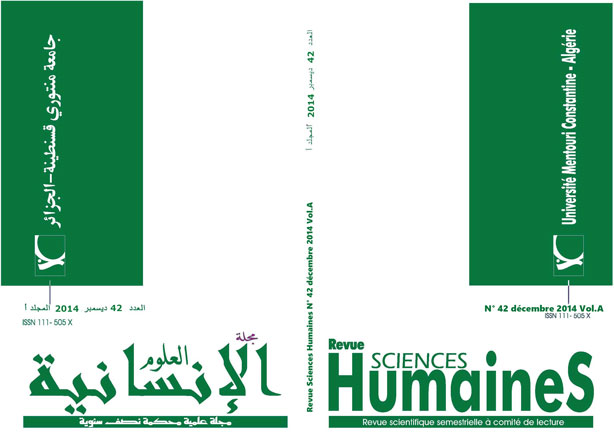The Effect of Learning Styles and Motivation on Students’ Vocabulary Acquisition: The Case of Second Year LMD Students of English at the University of Constantine1
الكلمات المفتاحية:
Students’ Vocabulary Acquisition، Second Year LMD Students، University of Constantine 1الملخص
This research aims at establishing the importance of learning styles and motivation in second language acquisition and their effect on vocabulary acquisition as a key aspect of developing proficiency in a second language. The educational setting in which this study takes place is the Department of Foreign Languages, Faculty of Letters and English Language, University of Constantine1. The underlying hypotheses is that if teachers focus on the learners’ learning styles and attempt to raise their motivation, this may help them for better vocabulary acquisition. The study consisted of administering a pre-test and a post test to control and experimental groups; a treatment of vocabulary activities was given to the experimental group. The tested sample is randomly selected from second year students of English (LMD) population. The results confirm the hypothesis and show that the learners learn nearly all the new words when teachers focus on their learning styles and raise their consciousness about how to use them and attempt to enhance their motivation while accomplishing the tasks. Some pedagogical suggestions are made for a more effective way to learn vocabulary and help teachers in their teaching through creating a motivating environment and matching their teaching methods with their learners’ styles.التنزيلات
المراجع
- Alexander, L.G. (1967).Fluency in English : An Integrated Course for Advanced Students. London: Longman.
- Brown, H.D. (2000). Principles of Language Learning and Teaching. 4thEd. New York: Longman, 142-43.
- Claxton, C., H. and P. H. Murrell. (1987).Learning Styles : Implication for improving educational practices. ASHE-ERIC Report No.4.Washington, D.C: Association for the Study of Higher Education.
- Chappelle, C. and P, Green (1992). Field independence /dependence in Second Acquisition Research. Language Learning, 42: 47-83.
- Dornyei, Z. (2005). The Psychology of Language Learner: Individual differences in Second Language Acquisition. Erlbaum Associates, Inc: New Jersey.
- Duffy, G. (2009). “Using Semantic Maping to Develop Word Meaning”. Explaining Reading: A Resource for Teaching Concept, Skills and Strategies. 2nd Ed. Guilford Press, 373.
- Elley, W. (1989). Vocabulary Acquisition from Listening to Stories. Reading Research Quarterly 24.
- Felder, R. M., & E. R. Henriques, (1995). Learning and teaching styles in foreign and
- second language education. Foreign Language Annuals, 28.
- Fontecha, A.F and M.T, Gallego (2012). “The role of Motivation and Age in Vocabulary Knowledge. Vigo International Journal of Applied Linguistics Vol.9, 41-2. Spain
- Gardner, R. C, Lalonde, R.N , and R. Moorcroft.(1985). « The role of attitudes and motivation in SLL : correlation and experimental consideration » .Language Learning, 35, 2: 42
- Gardner, R. C., & P.D. McIntyre (1991). A Students’ Contribution to SLL. Part II: Affective Variables. Language teaching 26.
- Keefe, J. W. (1991). Assessing Student learning styles : An over view . In Student Learning Styles and Brain Behaviour. Reston, VA: National Association of Secondary School Principals. 4
- Kim, Y. (2008). ‘The role of task-induced involvement and learner proficiency in L2 vocabulary acquisition’. Language Learning 58, 2.
- Laufer, B. and J. Hulstjin. (2001). ‘Incidental vocabulary acquisition in a second language: the construct of task induced involvement’. Applied Linguistics. Vol. 22.
- Ma, Qing .(2009). Second Language Vocabulary Acquisition. Great Britain: Die Deutsche Bibliotthek. 166
- MeDermott, P., Mordell, M., & J. Stoltzfus (2001). The Organization of Student Performance in American Schools: Discipline, Motivation, Verbal learning, and non Verbal Learning. Journal of Educational Psychology. 93, 65.
- Moreno, R. (2010). Theories of Motivation and Affect. Educational Psychology. John Wiley& Sons, Inc: University of New Mexico. 329
- Pintrich, P. R, Marx, R. W., & Boyle, R.A. (1993). Beyond Cold Conceptual Change: the role of motivation beliefs and classroom contextual factors in the progress of conceptual change. Review of Educational Research, 63(2), 193
- Reid, J. M.( 1995). Teaching/learning Style in the ESL/EFL Classrom. Boston: Heinle. 8
- Schmitt, N. (2008). “Vocabulary Acquisition.” In N.Schmitt (ed).Vocabulary in Language Teaching. Cambridge: Cambridge Language Education.
- Staehr, L.S.(2008). “Vocabulary size and the skills of listening, reading and writing”. Language Learning Journal 36:140-143.
- Takala, S. (1985). “Estimating students’ vocabulary size in foreign language teaching”. In kohonen, V.H VAN Essen and C.Klein Bratey, C.(eds). Practice and Problems in Language Testing. Tampere, Finland: Finish Assocition for Applied Linguistics.163.
- Troike, M.S. (2006). Introduction to Second Language Acquisition. New York: Cambridge University Press.86-87
- Witkin, H.A, et al. (1954). Personality through Perception. New York: Harper and Brothers.












